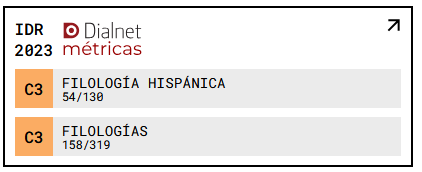Rewriting Love in the Twelfth Century
Ideology, Gender and Tradition in the "Roman d'Eneas"
DOI:
https://doi.org/10.18172/cif.6933Keywords:
Roman d'Eneas, Matter of Rome, French literature, medieval literature, love, AeneidAbstract
This article examines the representation of love in the Roman d’Eneas (ca. 1155-1160), a medieval adaptation of the Aeneid that reinterprets the classical poem through the social and narrative codes of feudal France. Through a comparative analysis of Aeneas’s contrasting relationships with Dido and Lavinia –the former, passionate and tragic; the latter, linked to marriage and dynastic continuity– the article traces the transformation of the theme of love from pagan eros to an aesthetic anticipating the roman courtois, via the commonplaces of Provençal fin’amors. The study explores the medieval author’s innovations and reveals not only the adaptation of values, genres and structures, but also the emergence of new female figures and a literary outlook that reflects the ideological tensions of the twelfth century.
Downloads
References
BASWELL, C. (1994). “Men in the ‘Roman d’Eneas’: The Construction of Empire”. En Lees, C. A. (ed.), Medieval Masculinities: Regarding Men in the Middle Ages. Minneapolis, University of Minnesota Press, pp. 149-168.
BERMEJO, E. (trad.) (1986). El libro d’Eneas. Barcelona, PPU.
BERMEJO, E. (1988). “‘Narratio’ y ‘argumentatio’ en los diálogos del ‘Roman d’Eneas’”. En Beltrán, V. (ed.), Actas del I Congreso de la Asociación Hispánica de Literatura Medieval. Barcelona, PPU, pp. 199-208.
BLUMENFELD-KOSINSKI, R. (1980). “Old French Narrative Genres: Towards the Definition of the ‘Roman Antique’”. Romance Philology, 34.2, 143-159.
CORBELLARI, A. (2009). “Retour sur l’amour courtois”. Cahiers de recherches médiévales et humanistes, 17, 375-385. https://doi.org/10.4000/crm.11542
CORMIER, R. (2006). “À propos de Lavine amoureuse : le Savoir sentimental féminin et cognitif”. Bien dire et bien aprandre, 24, 57-70.
DEIST, R. (1994). “The Kiss of Ascanius in Vergil’s ‘Aeneid’, the ‘Roman d’Enéas’ and Heinrich von Veldeke’s ‘Eneide’”. The German Quarterly, 67.4, 463-469. https://doi.org/10.2307/408670
DUBY, G. (1980). Hombres y estructuras de la Edad Media. Madrid, Siglo XXI.
FRAPPIER, J. (1973). Amour courtois et Table Ronde. Ginebra, Droz.
GAUNT, S. (1992). “From Epic to Romance: Gender and Sexuality in the ‘Roman d’Enéas’”. Romanic Review, 83.1, 1-27.
GONTERO, V. (2003). “De ‘l’amour celé’ au ‘semblant d’amor’. L’échange des anneaux dans l’épisode du manuscrit D du ‘Roman d’Eneas’ (ms. B.N.F fr. 60)”. Littératures, 48/49, 5-17. https://doi.org/10.3406/litts.2003.2209
GRILLO, P. R. (1968). “The Courtly Background in the ‘Roman d’Eneas’”. Neuphilologische Mitteilungen, 69.4, 688-702.
LEWIS, C. S. (1936). Allegory of Love. A study in Medieval Tradition. Oxford, Oxford University Press.
MARGOLIS, N. (1987). “‘Flamma’, ‘furor’ and ‘fol’amors’: Fire and feminine madness from the ‘Aeneid’ to the ‘Roman d’Eneas’”. Romanic Review, 78.2, 131-147.
MORA-LEBRUN, F. (1994). L’« Enéide » médiévale et la naissance du roman. París, PUF.
NELLI, R. (1972). Érotique et civilisations. París, Weber.
OVIDIO NASÓN, P. (1995). Obra amatoria. II, El arte de amar. Texto latino de Antonio Ramírez de Verger; introducción, traducción y notas de Francisco Socas. Madrid, Consejo Superior de Investigaciones Científicas.
PETIT, A. (1985). Naissances du roman. Les techniques littéraires dans les romans antiques du XIIe siècle. Ginebra, Editions Slatkine.
PETIT, A. (ed.) (1997). Le roman d’Eneas. París, Le Livre de Poche.
POIRION, D. (1976). “De l’‘Énéide’ à l’‘Énéas’: Mythologie et moralisation”. Cahiers de civilisation médiévale, 19, 213-229. https://doi.org/10.3406/ccmed.1976.2042
SALVERDA DE GRAVE, J. (ed.) (1891). Éneas, texte critique, publié par Jacques Salverda de Grave [Bibliotheca Normannica, 4]. Halle, Max Niemeyer.
SÁNCHEZ TRIGO, E. (1995). “Problemas de traducción de conceptos poéticos”. En Lafarga, F., Ribas, A., Tricás, M. (eds.), La traducción: metodología, historia, literatura: ámbito hispanofrancés [Actas del III Coloquio de la APFUE]. Barcelona, PPU, pp. 187-193.
TALARICO, K. M. (1981). “‘Fundare domum’: Medieval Descriptive Modes and the ‘Roman d’Eneas’”. Yale French Studies, 61, 202-224. https://doi.org/10.2307/ 2929883
TÉCHENER, J. (ed.) (1839). La chanson des saxons, par Jean Bodel. Publiée pour la première fois par Francisque Michel [Romans des douze pairs de France, 5-6]. París, Maulde et Renou, Imprimeurs.
VÀRVARO, A. (1983). Literatura románica de la Edad Media. Barcelona, Ariel.
ZINK, M. (1984). “Héritage rhétorique et nouveauté littéraire dans le ‘roman antique’ en France au Moyen Age : Remarques sur l’expression de l’amour dans le roman d’‘Eneas’”. Romania, 105.2/3, 248-269. https://doi.org/10.3406/roma.1984.1706
Published
How to Cite
Issue
Section
License
Copyright (c) 2025 Jorge Ginés Garrido

This work is licensed under a Creative Commons Attribution 4.0 International License.
The authors retain copyright of articles and authorize CIF the first publication. They are free to share and redistribute the article without obtaining permission from the publisher as long as they give appropriate credit to the editor and the journal.
Self-archiving is allowed too. In fact, it is recommendable to deposit a PDF version of the paper in academic and/or institutional repositories.
It is recommended to include the DOI number.
This journal is licensed under a Creative Commons Attribution 4.0 International License














